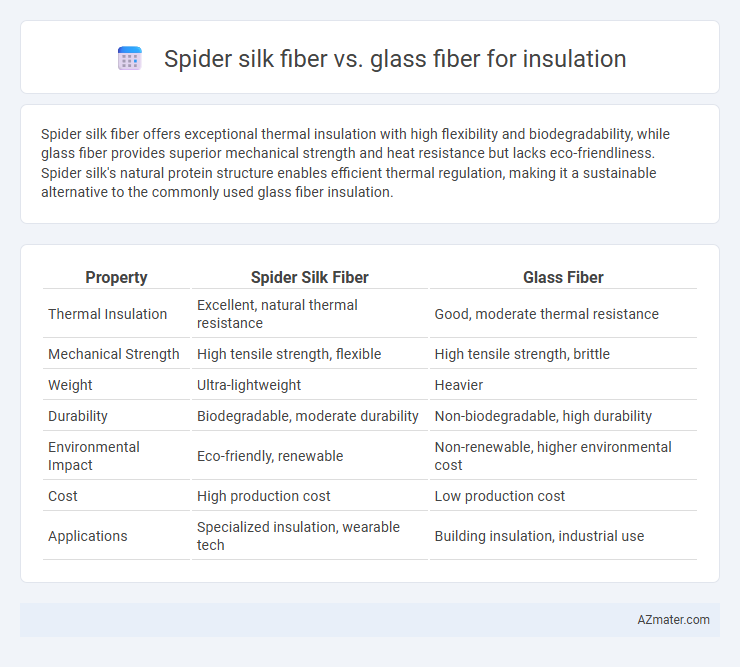Spider silk fiber offers exceptional thermal insulation with high flexibility and biodegradability, while glass fiber provides superior mechanical strength and heat resistance but lacks eco-friendliness. Spider silk's natural protein structure enables efficient thermal regulation, making it a sustainable alternative to the commonly used glass fiber insulation.
Table of Comparison
| Property | Spider Silk Fiber | Glass Fiber |
|---|---|---|
| Thermal Insulation | Excellent, natural thermal resistance | Good, moderate thermal resistance |
| Mechanical Strength | High tensile strength, flexible | High tensile strength, brittle |
| Weight | Ultra-lightweight | Heavier |
| Durability | Biodegradable, moderate durability | Non-biodegradable, high durability |
| Environmental Impact | Eco-friendly, renewable | Non-renewable, higher environmental cost |
| Cost | High production cost | Low production cost |
| Applications | Specialized insulation, wearable tech | Building insulation, industrial use |
Introduction: Insulation Materials Overview
Spider silk fiber offers exceptional tensile strength, flexibility, and biodegradability, making it a promising sustainable alternative for insulation. Glass fiber insulation, widely used in building and industrial applications, provides excellent thermal resistance and affordability but lacks the eco-friendly properties of spider silk. Both materials address energy efficiency, with spider silk emerging as a novel, environmentally conscious option compared to traditional glass fiber.
Composition and Structure: Spider Silk vs Glass Fiber
Spider silk fiber, composed primarily of protein-based fibroin with a crystalline and amorphous matrix, offers exceptional tensile strength and flexibility due to its hierarchical nanostructure. Glass fiber consists mainly of silica (SiO2), alumina, and boron oxides, forming an amorphous, brittle, and rigid structure ideal for thermal and electrical insulation. The proteinaceous, lightweight nature of spider silk contrasts with the inorganic, dense composition of glass fiber, influencing their respective thermal conductivity and mechanical properties in insulation applications.
Thermal Insulation Properties Comparison
Spider silk fiber demonstrates superior thermal insulation properties compared to glass fiber due to its low thermal conductivity and excellent moisture regulation capabilities. Its natural protein structure creates a lightweight, flexible material that traps air effectively, reducing heat transfer significantly more than the rigid, denser glass fiber. This makes spider silk fiber a highly efficient and sustainable alternative for thermal insulation in advanced building and textile applications.
Mechanical Strength and Durability
Spider silk fiber exhibits exceptional tensile strength and remarkable elasticity, outperforming many conventional materials in mechanical stress resistance. Glass fiber, widely used in insulation, offers high mechanical strength but is brittle and prone to cracking under extreme conditions. Spider silk's natural resilience and durability make it a promising alternative for long-lasting, flexible insulation applications where mechanical robustness is critical.
Environmental Impact and Sustainability
Spider silk fiber offers exceptional environmental benefits over glass fiber for insulation due to its biodegradability and renewable production from natural protein synthesis. Unlike energy-intensive glass fiber manufacturing that emits significant CO2 and generates non-recyclable waste, spider silk production consumes minimal resources and produces nearly zero harmful byproducts. Its sustainability footprint is further enhanced by spider silk's high strength-to-weight ratio, enabling effective insulation with less material use and reduced ecological harm.
Production Methods and Scalability
Spider silk fiber production relies on bioengineering techniques involving recombinant DNA technology in host organisms such as bacteria, yeast, or plants to synthesize silk proteins, followed by controlled spinning processes to form fibers. In contrast, glass fiber manufacturing uses high-temperature melting of silica-based raw materials and mechanical drawing to produce continuous fibers at industrial scales. Scalability favors glass fiber due to established high-volume factories and cost-efficiency, while spider silk fiber faces challenges in mass production despite advances in synthetic biology and protein expression systems.
Cost-Effectiveness Analysis
Spider silk fiber offers exceptional strength-to-weight ratio and biodegradability, making it a renewable insulation material but typically comes with higher production costs due to complex harvesting and synthesis processes. Glass fiber insulation is widely used owing to its low cost, ease of mass production, and effective thermal resistance, providing a more economically viable solution for large-scale insulation projects. Cost-effectiveness analysis favors glass fiber for budget-sensitive applications, while spider silk fiber holds potential for specialized uses where sustainability and mechanical performance justify the premium price.
Applications in Modern Insulation Technologies
Spider silk fiber exhibits exceptional thermal insulation and lightweight properties, making it a cutting-edge material in modern insulation technologies for aerospace and wearable applications. Glass fiber remains a dominant choice due to its high tensile strength, excellent thermal resistance, and cost-effectiveness, widely used in building insulation and industrial equipment. Innovations combining spider silk's biodegradability with glass fiber's durability are driving advancements in eco-friendly, high-performance insulation solutions.
Safety, Health, and Allergen Factors
Spider silk fiber offers superior biocompatibility and hypoallergenic properties compared to traditional glass fiber insulation, reducing risks of respiratory irritation and skin inflammation. Unlike glass fibers, which can cause microscopic glass shards to become airborne and pose inhalation hazards, spider silk fibers are biodegradable and non-toxic, enhancing indoor air quality. The natural moisture-wicking abilities of spider silk contribute to better mold resistance, promoting a healthier indoor environment without the harmful dust associated with glass fiber insulation.
Future Prospects and Innovative Developments
Spider silk fiber demonstrates remarkable tensile strength, elasticity, and biodegradability compared to traditional glass fiber, positioning it as a promising material for next-generation insulation applications. Advances in biomimetic engineering and synthetic spider silk production are enhancing scalability and cost-effectiveness, potentially transforming eco-friendly insulation markets. Emerging innovations integrate spider silk composites with nanotechnology, improving thermal resistance and sustainability, signaling a significant shift in future insulation material development.

Infographic: Spider silk fiber vs Glass fiber for Insulation
 azmater.com
azmater.com